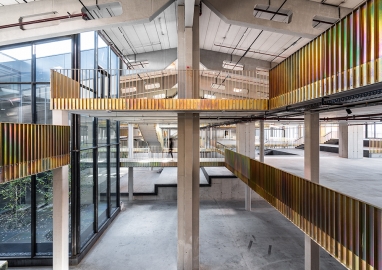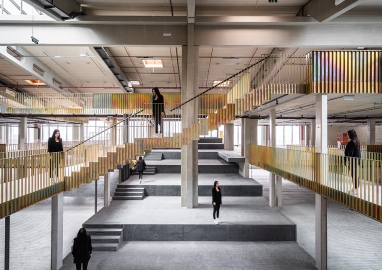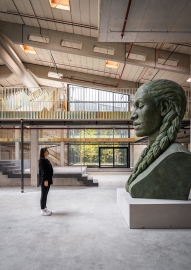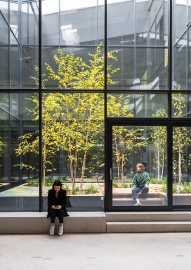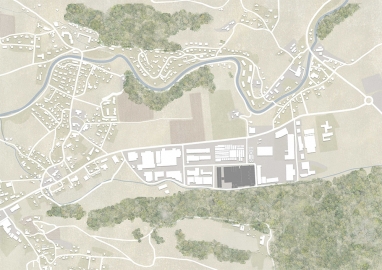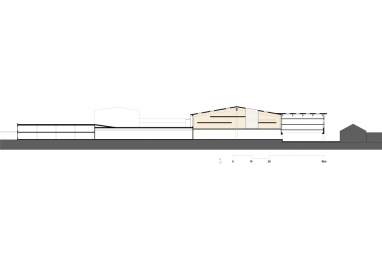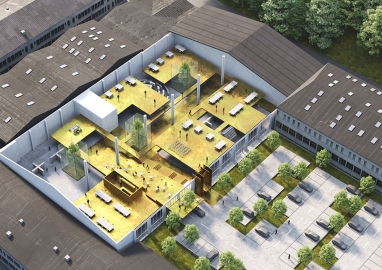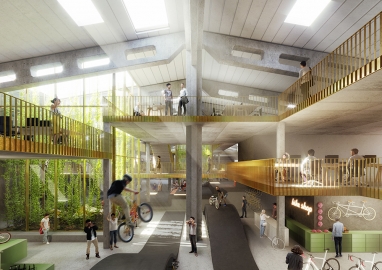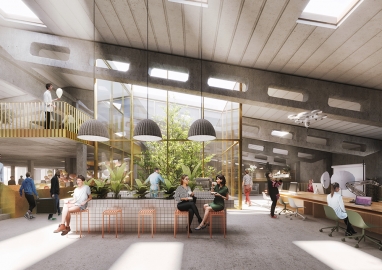Possibility space instead of building waste - Handelszentrum 16
“Handelszentrum 16” – How to turn empty and derelict industrial buildings into lively and resource saving opportunity spaces.
In the 1970s an industrial area was created in Bergheim, a picturesque village at the outskirts of Salzburg. In this industrial zone, which exists in similar form everywhere in Austria, the mail order company “Universal Versand” also set up its operation. Until the end of the 1980s, the concrete building was continuously expanded, adapted, and reconstructed. Tightly packed and fully built, nowadays the conglomerate consists of a loading yard, a high-rack warehouse, a storage building, and countless smaller extensions, and has a total of 30,000m² of usable space. In the following decades, increasing globalization and the emergence of online shopping platforms revolutionized the mail order business. As a result, these old warehouses were no longer needed, lost their use case and eventually were abandoned by Universal Versand.
But what do you do, with dark, vacant hangars, that were essentially designed as warehouses for pallets and crates and not as vibrant places for people? For the client Marco Sillaber and smartvoll Architekten, one thing was certain - don't demolish, reuse wisely and turn the disadvantages of the existing building into advantages.
From vacant warehouses the team developed the Handelszentrum 16, a multifunctional center for commerce, production, research and culture.
Contrary to common practice, the new use was not determined in advance and for all time but developed in the process and still is flexible in nature. For the area to come alive, the selection and the right combination of tenants was essential. The current usermix proves how flexible the project really is and must be. Among many others, Handelszentrum 16 offers space for a shrimp farm, showrooms, an ice cream production facility, physiotherapy practices, a ballet school, a digital content creation agency, a laboratory and a water based fitness device developer. This diversity is key and critical to build a thriving community of people in a formerly misanthropic environment.
So here we want to talk about what we did not construct by preserving the building as opposed what we constructed with a new building.
With the decision alone to not demolish this building we saved 0,5% of all of Austria’s yearly demolition waste. For the 68000 tons of concrete, that make up the building, 8760 tons of Co² were emitted into the atmosphere. Just take this 2 numbers and the decision to preserve the building and go down the minimal invasive route becomes very easy.
In Austria we have around 130km² of vacant industrial buildings, which is roughly the size of Graz – the second largest city in our country. So if we want to preserve resources and reduce land and energy consumption it is quintessential to defibrillate old and derelict buildings back to live before we even think about building new ones.
New strategies are needed for the sensible reuse of already sealed industrial areas that have lost their original purpose. The Handelszentrum 16 is just one example of how reasonable it really is to preserve already consumed resources and to bring them back to live with their potential to contribute to climatic and social challenges.


